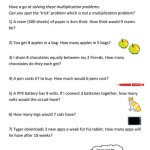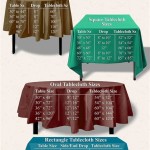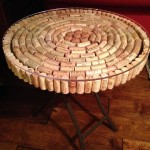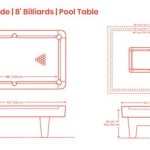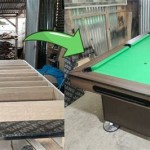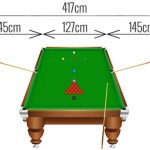Understanding 8ft Pool Table Dimensions: A Comprehensive Guide
The game of pool, also known as billiards, is enjoyed by millions worldwide. Its popularity stems from its strategic depth and the social aspect of engaging with others around a physical table. A critical factor in the enjoyment and playability of pool is the size of the table itself. While various sizes exist, the 8ft pool table is a common choice for both residential and commercial settings. This article delves into the specific dimensions of an 8ft pool table, exploring the standards, variations, and factors influencing these measurements. Understanding these dimensions is crucial for ensuring accurate gameplay, proper space planning, and informed purchasing decisions.
Regulation Sizes and Standard Dimensions
The term "8ft pool table" refers to the playing surface length, measured from bumper to bumper. Official regulations, particularly those established by organizations like the World Pool-Billiard Association (WPA), provide guidelines for pool table dimensions to ensure fair and consistent gameplay. The nominal size description of 8ft is an approximation. The actual playing surface typically measures around 88 inches (224 cm) in length and 44 inches (112 cm) in width. This yields a 2:1 ratio playing surface, which is a standard and crucial aspect of the game.
While the playing surface dimensions are relatively consistent across manufacturers adhering to these guidelines, the overall external dimensions of the table can vary. The external measurements include the width of the rails (bumpers) surrounding the playing surface. These rails, generally made of wood and covered with cloth, add to the overall footprint of the table. The total length of an 8ft pool table, including the rails, typically ranges from 98 to 102 inches, while the total width can range from 54 to 58 inches. It is important to note that these are approximate figures, and potential buyers should always check the manufacturer's specifications for the precise dimensions of a specific model.
The height of the pool table is another important dimension, although it is less prone to variation. The standard height, measured from the floor to the top of the playing surface (the cloth), is usually between 29.25 inches (74.3 cm) and 31 inches (78.7 cm). This height allows players of average stature to comfortably play while maintaining proper cueing and stance.
Factors Affecting Pool Table Dimensions
Several factors can contribute to slight variations in the dimensions of an 8ft pool table. These factors primarily relate to manufacturing processes, design choices, and material selection. While the playing surface dimensions are generally standardized, the overall size and shape can be affected by the construction of the rails and the cabinet (the table's base and frame).
The width of the rails is one of the most significant determinants of the table's overall external dimensions. Some manufacturers opt for wider rails, providing a more substantial and visually appealing aesthetic. Wider rails also offer a broader surface for players to rest their hands or cues. However, wider rails consequently increase the table's overall footprint, which is a crucial consideration when assessing the available space in a room.
The construction of the cabinet also plays a role. Tables with more ornate or elaborate cabinet designs tend to be larger than those with simple, streamlined designs. The materials used in the cabinet's construction, such as solid wood versus composite materials, can also influence the overall size and weight of the table. Solid wood cabinets might be slightly bulkier due to the material's inherent density.
Furthermore, the type of pockets used can affect the overall width. Some tables feature traditional drop pockets, while others have ball return systems. Tables with ball return systems usually have slightly wider cabinets to accommodate the internal mechanisms. Pocket design can also impact the way shots play around the rails, as the shape and size of the pocket opening can influence ball deflection.
Considering Room Size and Clearance
When considering an 8ft pool table, it is not enough to simply know the table's dimensions. It is equally important to account for the necessary clearance around the table to allow for comfortable gameplay. This clearance is the space required for players to comfortably maneuver around the table and use their cues without obstruction.
A general rule of thumb is to allow at least 5 feet of clearance around all sides of the table. This means that for an 8ft pool table (approximately 100 inches long and 56 inches wide), the room should be at least 18 feet long (100 inches + 60 inches + 60 inches) and 15.6 feet wide (56 inches + 60 inches + 60 inches). These dimensions assume the use of a standard 58-inch cue. If shorter cues are used, or if players are comfortable playing with limited backswing in certain areas, the required clearance can be slightly reduced.
It is crucial to consider the room's layout when assessing the required clearance. Obstructions such as walls, furniture, and support columns can significantly reduce the usable space. In such cases, it might be necessary to choose a smaller pool table or rearrange the room to ensure adequate playing space. The placement of lighting fixtures is also an important factor. Overhead lighting should be positioned to provide even illumination across the entire playing surface without casting shadows that could interfere with gameplay.
For competitive players or those who frequently host pool games, maximizing the clearance around the table is highly recommended. More space allows for greater freedom of movement and more comfortable shot execution, leading to a more enjoyable and competitive playing experience. In situations where space is limited, consider using shorter cues or specialized cues that allow players to shoot in tight corners.
Comparing 8ft Pool Tables to Other Sizes
While the 8ft pool table is a popular choice, it is essential to compare it to other common sizes to determine the best fit for specific needs and circumstances. The most common alternative sizes are 7ft and 9ft tables. Understanding the differences in dimensions and gameplay characteristics can help prospective buyers make informed decisions.
A 7ft pool table is smaller than an 8ft table, with a playing surface measuring approximately 76 inches long and 38 inches wide. This makes it a suitable option for smaller rooms or spaces where maximizing floor space is a priority. The shorter playing surface also generally results in faster-paced games, as the distances between balls are shorter, requiring less precise shot execution. However, experienced players might find the 7ft table to be too compact and less challenging than larger tables.
A 9ft pool table is the standard size used in professional tournaments and competitive play. Its playing surface measures approximately 100 inches long and 50 inches wide. The larger playing surface provides a more challenging and strategic gameplay experience, requiring greater precision and skill. However, a 9ft table requires significantly more space than an 8ft table, making it impractical for many residential settings. A room size of at least 20 feet long and 16 feet wide is generally recommended for a 9ft table, assuming the use of standard 58-inch cues.
The choice between an 8ft, 7ft, or 9ft pool table ultimately depends on the available space, the intended use, and the skill level of the players. The 8ft table represents a compromise between size and playability, offering a challenging yet manageable playing experience for both casual and experienced players. It is also versatile enough to fit comfortably in many homes or recreational spaces.
Measuring a Pool Table Accurately
When assessing the dimensions of a pool table, whether for purchasing, moving, or simply understanding its specifications, accuracy is paramount. Using the correct tools and techniques ensures that the measurements are reliable and that the table can be properly accommodated in its intended space.
The most essential tool for measuring a pool table is a reliable measuring tape, preferably one that is at least 120 inches (10 feet) long. A metal measuring tape is generally more accurate than a cloth tape measure, as it is less prone to stretching or distortion. Additionally, a level can be used to ensure that the table is positioned on a flat surface before taking measurements, as any unevenness can affect the accuracy of the results.
The playing surface length and width should be measured from the inside edges of the bumpers (rails). Ensure the tape measure is taut and aligned straight across the playing surface. For the overall external dimensions, measure from the outermost points of the table, including the rails. The height of the table should be measured from the floor to the top of the playing surface (the cloth). Repeat each measurement several times to ensure consistency and accuracy. If there are any discrepancies, take the average of the measurements.
When measuring for room clearance, account for any architectural features or existing furniture that might obstruct the playing space. Use a laser distance measurer for quick and precise measurements of longer distances. Always double-check the measurements and consider adding a small margin of error to account for unforeseen circumstances.
Finally, consult the specific pool table manufacturer's specifications. These specifications often provide detailed dimension information, including diagrams and tolerances. Manufacturers’ specifications can provide the most reliable information for a specific model.

Pool Table Size Chart Us 8ft Dimensions Sizes

Pool Table Room Size Calculator

Measuring A Pool Table For Quality And Fair Play Sports Dimensia

Pool Table Size Chart Moving The Experts

What Room Size Do I Need For My Pool Table Liberty

How To Measure A Pool Table 4 Dimensions

Room Size Specifications Olhausen Billiards

Room Size Pooltables Com

Pool Table Room Size Guide Home Leisure Direct

Faq Shehen Xingjue Billiards Co Ltd


